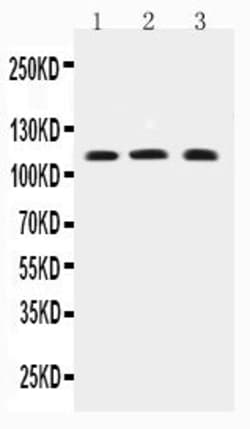Learn More
Invitrogen™ TRPC4 Polyclonal Antibody
Rabbit Polyclonal Antibody
Supplier: Invitrogen™ PA595170
Description
Reconstitute with 0.2 mL of distilled water to yield a concentration of 500 μg/mL. Positive Control - WB: COLO320 whole cell, MCF-7 whole cell, PANC whole cell. Store at -20°C for one year from date of receipt. After reconstitution, at 4°C for one month. It can also be aliquotted and stored frozen at -20°C for six months. Avoid repeated freeze-thaw cycles.
TRPC4 is a member of the canonical subfamily of transient receptor potential cation channels. TRPC4 forms a non-selective calcium-permeable cation channel that is activated by Gq-coupled receptors and tyrosine kinases, and plays a role in multiple processes including endothelial permeability, vasodilation, neurotransmitter release and cell proliferation. Single nucleotide polymorphisms in TRPC4 may be associated with generalized epilepsy with photosensitivity. Alternatively spliced transcript variants encoding multiple isoforms have been observed for TRPC4. The classical or canonical transient receptor potential (TRPC) channels are the subfamily most closely related to the founding member of the TRP family, the Drosophila TRP channel. TRPC channels have seven TRPC genes that encode the channel protein (TRPC1-7). Diseases associated with TRPC4 include Photosensitive Epilepsy.CaV3.3 encodes the pore-forming alpha subunit of a voltage gated calcium channel. The encoded protein is a member of a subfamily of calcium channels referred to as is a low voltage-activated, T-type, calcium channel. The channel encoded by CaV3.3 is characterized by a slower activation and inactivation compared to other T-type calcium channels. CaV3.3 may be involved in calcium signaling in neurons. Alternate splicing results in multiple transcript variants of CaV3.3. Voltage-gated calcium channels (CaV) are present in the membrane of most excitable cells and mediate calcium influx in response to depolarization, an proteins such as CaV3.3 regulate intracellular processes such as contraction, secretion, neurotransmission and gene expression. Diseases associated with CACNA1I include Childhood Absence Epilepsy.
Specifications
| TRPC4 | |
| Polyclonal | |
| Unconjugated | |
| Trpc4 | |
| alpha TRPC4; beta TRPC4; beta-2 TRPC4; capacitative calcium entry channel 1; capacitative calcium entry channel Trp4; CCE1; HTRP4; HTRP-4; MGC119570; MGC119571; MGC119572; MGC119573; putative capacitative calcium entry channel; receptor-activated cation channel TRP4; Short transient receptor potential channel 4; STRPC4; transient receptor potential cation channel subfamily C member 4; transient receptor potential cation channel, subfamily C, member 4; transient receptor potential channel 4; transient receptor potential protein 4; transient receptor protein 4; Trp4; TRPC 4; Trpc4; Trpc4_v2; trp-related protein 4; Trrp4 | |
| Rabbit | |
| Affinity chromatography | |
| RUO | |
| 7223 | |
| -20°C | |
| Lyophilized |
| Western Blot | |
| 500 μg/mL | |
| PBS with 5mg BSA and 0.05mg sodium azide, 0.05mg thimerosal | |
| Q9UBN4 | |
| Trpc4 | |
| A synthetic peptide corresponding to a sequence at the C-terminus of human TRPC4 (961-977aa LNLPDTVTHEDYVTTRL). | |
| 100 μg | |
| Primary | |
| Human | |
| Antibody | |
| IgG |
Safety and Handling
Your input is important to us. Please complete this form to provide feedback related to the content on this product.
